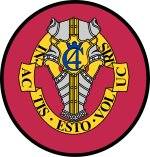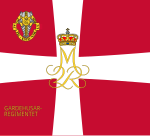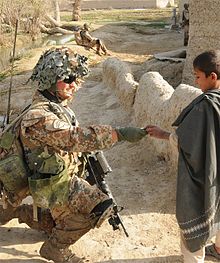| Guard Hussar Regiment | |
|---|---|
| Gardehusarregimentet | |
 Cap badge of the Guard Hussars Cap badge of the Guard Hussars | |
| Active | 17 November 1614 – present (410 years, 1 month) |
| Country | |
| Branch | |
| Type | Mechanized infantry |
| Role | Maneuver warfare Raiding Reconnaissance |
| Size | Five battalions |
| Part of | Army Staff |
| Garrison/HQ | I. & II. Battalion – Antvorskov barracks III.Battalion – Bornholm |
| Nickname(s) | GHR |
| Motto(s) | In Actis Esto Volucris (Be swift in action) |
| Regimental belt | |
| March | Garderhusarregimentets Signalmarch Play |
| Anniversaries | 17 November 1614 10 February 1762 |
| Engagements | Thirty Years War Torstenson War Second Nordic War Scanian War Nine Years' War War of the Spanish Succession Great Nordic War Napoleonic Wars First Schleswig War Second Schleswig War Operation Weserübung War in Afghanistan (2001–2021) Iraqi conflict |
| Website | www |
| Commanders | |
| Current commander | Colonel Jens Ole Rossen-Jørgensen |
| Ceremonial chief | HM The King |
| Notable commanders | Peder Aalborg Caspar Hermann Gottlieb Moltke |
| Insignia | |
| Colours |  |
| Standard |  |
| Former coat of arms |  |
The Guard Hussar Regiment (Danish: Gardehusarregimentet, GHR) is a cavalry unit of the Royal Danish Army, whose primary task is to train the Guard Hussars for various functions in the mobilisation force. The Guard Hussar Regiment is one of two active cavalry regiments of the Danish Army, and was formed in 2001 through the amalgamation of the original Guard Hussars regiment, Zealand Life Regiment and Danish Life Regiment.
History
Origins of the regiment

Although the Guard Hussars themselves date from 10 February 1762, the Danish Army takes the date of the founding of a regiment from its oldest part, in this case the Zealand Life Regiment, which was founded in 1614. This makes the Guard Hussars one of the oldest regiments of hussars in the world still operational, it is also the only hussars in mounted parade uniform to still wear the slung and braided pelisse which was formerly characteristic of this class of cavalry. In addition to its operational role, the Guard Hussar Regiment is one of two regiments in the Danish Army (along with the Den Kongelige Livgarde) to be classed as 'Guards'; in this case, the Mounted Squadron perform the same role as the Household Cavalry do in the British Army.
From 1961 to 1972 the regiment was responsible for two armoured battalions, one recon battalion. From 1972–2000 the regiment was responsible for one armoured, one mechanised infantry, one reconnaissance and one infantry battalions. From 2000–2004 the regiment was responsible for two armoured, two mechanised infantry, one reconnaissance and two infantry battalions. From 1992–2004 the regiment also had to form two light Reconnaissance Squadrons assigned to the 1st Zealand Brigade and Danish International Brigade.
2001 amalgamation
As part of the Defence Agreement 2000–04, it was decided to merge the Guard Hussar Regiment with the Zealand Life Regiment and the Danish Life Regiment. With this amalgamation of the three infantry regiments, the name and history of the new regiment had to be decided. This led to what the media called "the Colonels' War" (Danish: Oberstkrigen), with the three colonels fighting for their regiment’s name and history to survive. The Chief of Defence, Christian Hvidt, ordered the old insignia removed, which was not customary. The new armoured horse head was nicknamed the "biker patch". Furthermore, it was decided that a colour be used alongside the standard.
Modern times
Following the amalgamation, the Guard Hussar Regiment has participated in a number of international missions, resulting in the loss of 16 soldiers.
Structure
Current units
Today the Gardehusarregiment is classed as a cavalry regiment, it is in fact a mixed armoured and infantry unit, with three battalions:
 Guard Hussar Regiment, in Slagelse
Guard Hussar Regiment, in Slagelse
 I Armoured Infantry Battalion – assigned to 1st Brigade; Motto: Hurtig i tanke og handling, livsfarlig for sine fjender (Quick in thought and action, deadly to his enemies)
I Armoured Infantry Battalion – assigned to 1st Brigade; Motto: Hurtig i tanke og handling, livsfarlig for sine fjender (Quick in thought and action, deadly to his enemies)
 Staff Company (SLEIPNER) Motto: Altid Klar (Always Ready)
Staff Company (SLEIPNER) Motto: Altid Klar (Always Ready) 1st Armoured Infantry Company (1/I/GHR or VIDAR) Motto: Når storm lægger sig raser vi stadig (When the storm subsides we rage on)
1st Armoured Infantry Company (1/I/GHR or VIDAR) Motto: Når storm lægger sig raser vi stadig (When the storm subsides we rage on) 2nd Mechanised Infantry Company (2/I/GHR or ULTRA) Motto: Non plus ultra (Nothing further beyond)
2nd Mechanised Infantry Company (2/I/GHR or ULTRA) Motto: Non plus ultra (Nothing further beyond) 4th Mechanised Infantry Company (4/I/GHR) (inactive)
4th Mechanised Infantry Company (4/I/GHR) (inactive)
 III Reconnaissance Battalion – assigned to 2nd Brigade; Motto: Nec temere nec timide (Neither random nor timidly)
III Reconnaissance Battalion – assigned to 2nd Brigade; Motto: Nec temere nec timide (Neither random nor timidly)
 Staff Squadron (Inactive)
Staff Squadron (Inactive) 1st Light Reconnaissance Squadron (1 LOPKESK)
1st Light Reconnaissance Squadron (1 LOPKESK) 2nd Light Reconnaissance Squadron (2 LOPKESK) nickname: Spøgelserne fra Bornholm (The ghosts from Bornholm)
2nd Light Reconnaissance Squadron (2 LOPKESK) nickname: Spøgelserne fra Bornholm (The ghosts from Bornholm) 3rd Light Reconnaissance Squadron (3 LOPKESK)
3rd Light Reconnaissance Squadron (3 LOPKESK)- Marine Squadron (4th Training Squadron) - Motto:Klar til kamp – altid i front (Ready to fight - always in front)
 V Training Battalion – assigned to 2nd Brigade; Motto:Terror in Hostes – Vor fjender til frygt
V Training Battalion – assigned to 2nd Brigade; Motto:Terror in Hostes – Vor fjender til frygt
 Staff Company (Inactive)
Staff Company (Inactive) 1st Training Company - 8 Month Mobilization Conscription - Motto:Fremad på ny – hurtig og adræt (Forward again - fast and agile)
1st Training Company - 8 Month Mobilization Conscription - Motto:Fremad på ny – hurtig og adræt (Forward again - fast and agile) 2nd Training Company (Livkompagniet) - 4 Month Training Conscription - Motto:Fremad på ny – lige på og hårdt (Forward again - head on)
2nd Training Company (Livkompagniet) - 4 Month Training Conscription - Motto:Fremad på ny – lige på og hårdt (Forward again - head on) 4th Mechanised Infantry Company (4/V/GHR) 8 Month Training Conscription
4th Mechanised Infantry Company (4/V/GHR) 8 Month Training Conscription
 Mounted Squadron – 4 Month Training and 8 months taking care of the regiments horses and public and ceremonial duties
Mounted Squadron – 4 Month Training and 8 months taking care of the regiments horses and public and ceremonial duties
Officially disbanded units
 II/GHR Armoured Battalion (1955−1976), Infantry Battalion (1977-2000), Armoured Infantry Battalion (2001-2018)
II/GHR Armoured Battalion (1955−1976), Infantry Battalion (1977-2000), Armoured Infantry Battalion (2001-2018) IV/GHR Infantry Battalion (1983−1996), Armoured Infantry Battalion (1997-2013).
IV/GHR Infantry Battalion (1983−1996), Armoured Infantry Battalion (1997-2013). VI/GHR Infantry Battalion (2000-2004).
VI/GHR Infantry Battalion (2000-2004). VII/GHR Infantry Battalion (2000-2004).
VII/GHR Infantry Battalion (2000-2004).
Names of the regiment
| Husarregimentet | Hussar Regiment | 1762-02-10 | – | 1780 |
| 1. og 2. Husaregiment | 1st and 2nd Hussar Regiment | 1780 | – | 1785 |
| 1. og 2. Husarkorps | 1st and 2nd Hussar Corps | 1785 | – | 1788 |
| Husarregimentet | Hussar Regiment | 1788 | – | 1842 |
| Garderhusardivisionen | Guard Hussar Division | 1842 | – | 1855 |
| Husarregimentet | Hussar Regiment | 1855 | – | 1856 |
| Gardehusarregimentet | Guard Hussar Regiment | 1856 | – | Present |
References
- "The Guard Hussars". Archived from the original on May 13, 2011. Retrieved July 25, 2009.
- "Regimentets historie". forsvaret.dk (in Danish). Gardehusarregimentet. Retrieved 28 September 2018.
- Brøndum, Christian (17 November 2014). "Dronningen fejrer tvivlsomt jubilæum". b.dk (in Danish). Berlingske Media. Retrieved 28 September 2018.
- Brøndum, Christian (November 2016). Baunehøj, Birgit (ed.). "Forsvaret går ikke med rygmærker" (PDF). Forsvarsavisen. 5 (8). Værnsfælles Forsvarskommando: 7. Retrieved 21 November 2018.
- Brøndum, Christian (29 April 2002). "Gammelt nag ruster ikke" (in Danish). Berlingske Tidende. Retrieved 21 November 2018.
- "Danske militære tab i international tjeneste". fns-naestved.dk (in Danish). 31 May 2014. Retrieved 1 October 2018.
- Laursen, Ole (22 April 2014). "Historical Overview of Guard Hussar Regiment". Wadschier. Retrieved 5 June 2017.